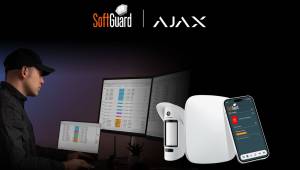By Ana María Restrepo
With the increase in corporate developments, research, insecurity and crimes, thousands of companies, schools, governments, etc., have implemented Closed Circuit Television within their organizations, in the streets, in schools and even in public transport systems such as trains and buses.
Traditional CCTV systems have been the best known in the field of security and surveillance, but the digital development and the influence of information technologies have allowed progress towards other forms of recording and transmission that for more than two years have been revolutionizing and modifying CCTV.
Early CCTVs were composed of analog cameras that used coaxial cables to connect in home-run to multiplexers that powered several video recorders in a central control room. The images could be monitored in real time through several monitors or in a single one with the possibility of changing to the requested camera, however the high cost of the monitoring station and the recording system on magnetic tapes that became obsolete incited the development of another technology that met the needs that were constituted.
Digital Video Recorders (DVRs) became that solution that solved the problems of magnetic tapes when recording in digital format to a hard drive or other media and you do not need to change the tape for the recording to continue. Also, the appearance of IP cameras revolutionized the transmission system and in a way became the perfect alternative to analog systems, although they can also be incorporated together with the old systems and create hybrid CCTV
More than two years ago IP cameras began to enter firmly, allowing a stronger digitization between capture and recording, in addition to facilitating and making the process more agile because they are linked by computer networks, Internet or wireless networks.
For many integrators the total migration to the new technology is not the most recommended because they do not adapt to the needs of customers and much less to the geographical conditions of Latin America, in addition some of them consider that the quality of analog video can not be compared with that of a digital system.
However, most integrators think that it would be much better to combine the benefits of an analog CCTV with a digital or IP one, since it allows you to take the best of each technology and integrate them to obtain better results.
We could say that the discussion about the benefits of analog and digital CCTV, or the use of one and the other, ended when hybrid systems appeared; However, to talk about this topic, its advantages and how these systems are created, VENTAS DE SEGURIDAD interviewed three electronic security professionals, specialists in Closed Circuit Television.
Technological migrations
To begin with, we could say that when we refer to the changes produced by a CCTV by IP we talk about the transmission devices, because previously coaxial cables were used and now with the IP we refer to the Internet which allows the transmission of voice and data, in addition to the camera or the video recorder can be assigned an address n IP and be within the network with the other elements that are there, as long as you have a good network infrastructure since when transmitting by this means you often have so much information that the communication route is saturated.
But which is better, an analog or digital CCTV? For many people, fashion and novelty lead them to make the decision to install a digital CCTV without taking into account their needs; but on the other hand analog systems, linked by coaxial cables tend to disappear, which is why the combination of these traditional systems with an IP transmission system, which offers the benefits of DVR recording and IP transmission or NVR recording, it offers the end user high advantages, in addition to achieving good acceptance and good performance to meet their needs.
"A hybrid system is another method of migrating from existing analog CCTV systems to digital technology increasingly," says Mirna Castañeda, Everfocus' regional manager for Mexico.
For his part, Cesar Augusto Gonzalez, vice president of sales and market development for Latin America and the Caribbean of Digiop Technologies, says that a hybrid system is the one that receives the signal from conventional analog cameras and in turn IP cameras, allowing them to coexist and operate transparently to the operator.
He also states that for a CCTV to be hybrid it only needs a good processor that allows you to capture analog video through video inputs and that at least makes it possible to integrate an IP or megapixel camera into your software.
However, there are other ways to create a hybrid CCTV by combining a DVR (Digital Video Recorder), which receives the video signals analogously and through its hardware digitizes the video to be able to store it, and an NVR (Network Video Recorder), which receives the video in IP "streams" (streams) that are sent by the edge devices: IP cameras and IP encoders (Encoders), which deliver the digitized video to the recorder, as Explained by Alexander Gutierrez, of Samsung GVI. "Until recently these elements (DVR and NVR) were obtained separately, however hybrid technology allows them to be combined into one, enabling savings in costs, space, energy, protections and accessories such as monitors, joystick controllers and workstations," he said.
A hybrid solution is a good strategy to take advantage of new technologies and continue using the analog system without having to do without its services and make excessive expenses, since it offers a high potential for integration with IP or digital systems. These systems accept low-cost analog cameras and at the same time sophisticated IP cameras that have megapixel resolution, or even intelligent DSPs to perform facial recognition.
It should be noted that according to the comments of professionals the main condition for a system to be hybrid is that it allows the reception and recording of both analog and IP signals in the same equipment, whether DVRs, NVRs, servers or recorders and that at the same time supports the sending of said signals through of a local network or IP. One of the main advantages offered by an IP CCTV is that each camera can be monitored from anywhere in the world through an Internet connection, as well as the record of the recorded images can be consulted by camera, date and time without having to check all the tapes to find the desired image.
Technology integration
Integration and open architecture allow different security systems from different manufacturers to come together and work seamlessly creating good solutions for the protection of assets and people. CCTV are the most implemented solutions in the industry and the best known, because of this thousands of users have a CCTV as their security system or within it, which is why the developments that are achieved in this field will be very well received, however, it should be borne in mind that new technologies are not always adapted to all companies, which generates the search for new solutions such as linking the analog elements of CCTV with digital ones.
According to Gutierrez normally in an IP solution analog inputs (cameras) are integrated through IP encoders and analog outputs (monitors) are connected to IP decoders. In a hybrid solution the recording equipment has analog inputs (commonly BNC connectors) and analog (BNC) or digital (SVGA) outputs to directly connect analog video, audio and alarm (inputs/outputs) signals. Incoming IP signals are received by the Ethernet interface, for which Gigabit speed is normally recommended.
For his part, César explains that what is done for the system to accept IP or megapixel cameras, is to develop a software that allows receiving the videos from new technology cameras, "the success of the integration is that through the software, on the display screen the operator can see analgogias, IP and Megapixel cameras at the same time, without having to do many operation steps, in the end what we want is a system rich in features but easy to operate"
Benefits of heterogeneity
According to Mirna, the trend in the ccTV world is to migrate to truly digital platforms as the costs of these become more accessible and more IP solutions are developed. However, González and Gutierrez consider that analog systems have several advantages, such as that in a single platform the client can use their already installed cameras without having to discard them and replace their entire system, and in turn can connect digital IP cameras that day by day are being generalized in the facilities. It also has benefits at the budget level, because unlike an IP solution, a hybrid allows you to use the existing infrastructure (cameras, installation) and take advantage of the benefits of the IP solution for new cameras in a transparent way for the end user because the interface is the same.
Similarly, César and Alexander agree that in comparison the costs between a digital CCTV and a hybrid one are great, since having an analog CCTV no longer has to add any hardware, because a hybrid system allows you to receive the same analog cameras and in turn IP cameras; Likewise, a hybrid recorder can have costs similar to those of an NVR, although the fact of allowing the use of the existing "analog" infrastructure and unifying the entire system in the same interface in many cases favors the hybrid solution.
For his part, Castañeda says that the industry faces the challenge of the lack of adopted standards and relying on expensive software systems to have a bridge over incompatible solutions.
Faced with the fashion of the new and the obsolete of the old, hybrids allow to unite the two systems and provide end users with benefits that both analog and IP individually could not provide. Regarding this issue, Gutiérrez considers that if a client does not have any existing infrastructure, the decision (apart from costs) would be the IP solution, since it would be based on the quality of the image, looking at parameters such as resolution and latency times (the very small delays that occur in the IP solution caused by the transmission. n of the signal), understanding, according to him, that this is the one that will end up imposing. "The hybrid solution is an intermediate step between DVRs and NVRs that in many cases is interesting for those customers who have an existing installation; you would have to do an analysis on cameras and cabling and compare the benefits and costs of keeping the current against investing in a fully IP solution."
In turn, González considers that price and flexibility of expansion are some of the reasons to choose a hybrid, since an analog system is limited to its maximum number of camera inputs, while a hybrid system can expand into the new IP cameras.
Hybrids for Latin America
As we have mentioned in different editions, the geographical and economic conditions of Latin America hinder the use and implementation of many of the new technologies. According to César González, in Latin America having 100% digital solutions is very expensive due to the high prices of connectivity, in addition there are thousands of analog cameras already installed that customers can not rule out to move to new technologies, This is why solutions of 4 to 32 hybrid channels are offered for a much lower price that allow connecting ningogue, IP and megapixel cameras from different manufacturers in a single software platform compatible with each other and very easy to operate.
For his part, Alexander believes that "there is no better CCTV solution for Latin America, what exists is the best solution for each application regardless of whether it is located in Tokyo, Mexico, Madrid or Santiago". For him, the important thing is that the end user chooses the solution based on the final result: the video signal he has live and the one he has in the playback of the recorded video. "Normally an end user who has never had a CCTV system will not have many parameters to compare and opt for the IP solution because they think that technologically it is more advanced and Latinos like to 'be fashionable' if we have the budget for it. However, a user who has already had an "analog" solution installed and is looking to upgrade their system to hybrid or IP, will surely compare the performance of live IP video with what they have previously obtained with their analog system, "he said.
Also this professional considers that in the region the Internet connection channels are expensive which makes monitoring through the network more expensive, which is why many users prefer a DVR solution that receives analog signals from the cameras and allows to consult the video by network, both locally and online.
To conclude, Mirna considers that IP infrastructure in Latin America is not yet very mature, so she believes that hybrid CCTV systems are an excellent option for this region, especially when considering the investment involved in a fully digital installation.

























Leave your comment